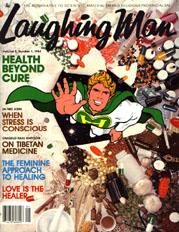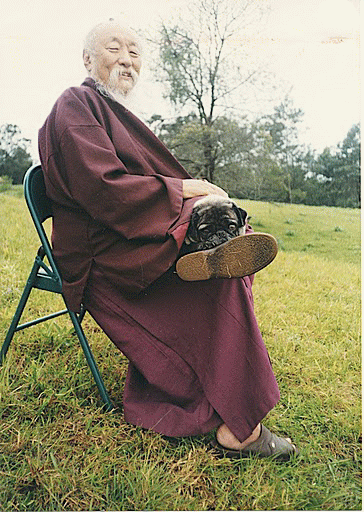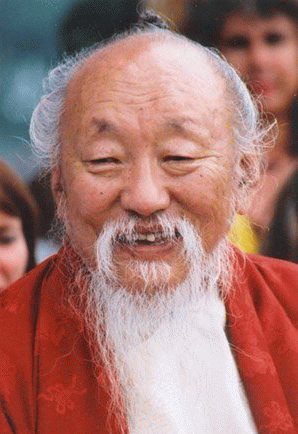
Vol 5 No 1, 1984
Lama Chagdud Tulku
Rinpoche
Doctor, Artist, &
Teacher
an interview with the Laughing Man staff – Georg Feuerstein


Lama Chagdud Tulku Rinpoche is a Tibetan Buddhist lama who is also a doctor of Tibetan medicine and an accomplished storyteller, singer, and artist. In his Tibetan cultural show – “In the Land of the Snow Lion, “communicated by stories, songs, and a slide show – Chagdud Rinpoche recaptures the culture of his native land, the wind-swept Tibetan plateau with its fierce, colorful people. It is a culture almost destroyed by the Chinese takeover of Tibet in 1959, a culture that survives today in the Tibetan refugee settlements of India and Nepal.
After fleeing from the Chinese at the age of 29, Chagdud Rinpoche lived for twenty years in the refugee camps, choosing to be among the poorest Tibetans, serving them as a spiritual teacher, physician, and counselor. He came to the United States four years ago at the request of American students of Tibetan Buddhism and lives in Cottage Grove, Oregon, where he acts as a medical consultant for two physicians in Eugene. He travels widely on the West Coast, teaching and building statues. Chagdud Tulku has created six major statues of Tibetan meditational deities since arriving in America in 1979. The largest of these is a work of sculpted and painted cement standing twenty-two feet high.
The first impression that anyone is likely to have of Lama Chagdud Tulku Rinpoche is that he is a kindly, cordial, and courteous person with much native wit. That certainly was the impression of Georg Feuerstein, who interviewed Rinpoche for THE LAUGHING MAN, and who also had occasion to talk informally with him for several hours afterward. A man of shortish, rounded stature and an age difficult to guess, Chagdud Rinpoche is a spiritual teacher with a commanding presence. In the course of the afternoon and evening, it became obvious, if there was any doubt to begin with, that Chagdud Tulku is no theoretician in spiritual matters and that he is more than a practitioner of Tibetan medicine.
The interview and subsequent conversation had a touch of the exotic, since Chagdud Tulku only speaks a kind of “telegraphic” English, ably interpreted and rendered into good prose by a woman student of his. What makes this feat of interpretation possible is the psychic resonance, or telepathic link, between teacher and disciple. By the end the evening, others had picked up some this skill.
During the social gathering in the evening, Chagdud Tulku gained everyone’s respect through his charm, simplicity, and natural humility. He expressed a keen interest in the Adept Da Free John and his Teaching. Although his questions were probing, he seemed genuinely delighted at the information given to him about Master Da Free John’s life and work.
As our readers can judge for themselves from the photographs accompanying this article, Lama Chagdud Rinpoche is also an accomplished artist. He under, stands his extraordinary sculptures as vehicles for the spiritual power of the beings — the female Deity Tara and Guru Padmasambhava – they represent. (Tara is the Tibetan Goddess of Mercy. Guru Padmasambhava was the founder of Tibetan Buddhism and is that country’s greatest spiritual and cultural hero.)
According to the traditional medical theory of Tibet, all disease is caused by imbalances arising from primordial. ignorance, or the erroneous assumption that there is a separate, independent self. Explains Yeshe Donden, personal physician to the Dalai Lama, “On a gross level, this would be belief in a self that is permanent, partless, and independent. In a more subtle misunderstanding, it is belief in a self that is empty yet seems to be self-sufficient. And on the most subtle level, it is the belief in a self that is felt to be inherently existent, is felt to exist from its own side, in its own essence. There is no such self. ” 1
1, Foundations of Tibetan Medicine,” Vajradhatu Sun, October/November 1983.
Primordial ignorance, our companion as long as we retain any vestige of selfhood, gives rise to the three ‘poisons ‘: delusion, greed, and anger. Arising in the mind, the three poisons produce three “humors” which pervade the human or organism. These humors are composed of the four primal elements: form (earth), life (water), feeling (fire), and awareness (air). With each humor having five aspects, there are a total of fifteen, which we translate as phlegms (composed of form and life, or earth and water); bites (composed of feeling, or fire); and winds (composed of awareness, or air).
To maintain health, the humors, or psycho physical elements, must be in balance with the seven constituents of the physical body (nutrients, blood, flesh, fat, bone, bone marrow, and reproductive matter) and the three waste products (urine, feces, and perspiration) When the relationship between any of the psycho-physcial elements of the human organism becomes imbalanced, illness or disease results.
Clearly implied in Tibetan medical theory is a Transcendental definition of health: Only the Enlightened, or selfless person can be perfectly healthy. For all others the Tibetan physician has a multitude of tangible and intangible elements to consider; it is readily apparent that he is nothing less than a practitioner of psycho physical medicine. Included in his repertory of medical arts are pulse diagnosis, urine analysis, pharmacology, herbology, medicinal oils, medicinal baths, massage, acupuncture, acupressure, moxibustion, and surgery.
THE LAUGHING MAN: Tibetan medical diagnosis is quite different from Western medical diagnosis. How do Tibetan doctors diagnose their patients?
RINPOCHE: Usually in Tibet there is one man in every village who acts as doctor. While in good health, all the people in the village visit the doctor to establish what kind of pulse is normal for them. The doctor then tells them, “You have a male pulse,” or “You have a female pulse,” or “You have a neutral pulse.” That is our foundation. So, later, you could consult the doctor and say, “Something doesn’t feel quite right. I would like my pulse checked; normally it is male.” If your pulse is found to be acting like a female pulse, you know something is wrong and, knowing what normal is, the doctor can begin checking for imbalances.
In pulse diagnosis, three fingers of each hand are used, with two pulses per finger. So, a total of twelve pulses can be found. This means that the condition of twelve different organs or glands can be diagnosed. If this kind of pulse diagnosis leaves any doubt, the doctor can move on to analyze the urine. He might at that point have a certain hypothesis, but without revealing what he thinks, he will ask the patient for more information. He is looking for support for the results of his pulse and urine analyses, asking questions about possible causative factors. For example, he might ask, “Three months ago did you jump into a cold lake and run around naked?” He will, of course, also take into account the patient’s general appearance–complexion, eyes, and so forth. Making use of the whole package of information, he will arrive at his diagnosis,
THE LAUGHING MAN: Does Tibetan diagnosis extend to mental conditions as well?
RINPOCHE: The mind and the body are interrelated, so when you examine the body you also learn the condition of the mind. The specific details of a neurotic condition are not revealed, but through the pulse it is understood whether or not a person is mentally stable or unstable.
THE LAUGHING MAN: To classify diseases according to physical or mental causes is a Western custom. How are the causes of disease understood by Tibetan medicine?
RINPOCHE: In Tibetan theory there are four causes of disease. The first is some kind of inappropriate activity, like jumping in a cold lake and running around naked. You just need to discontinue it, and you will get over your cough.
The second cause of disease is reaction to external conditions beyond your control. For example, you are reacting to something toxic that got into your water supply, and the only thing that will prevent you from dying is the administration of an antidote.
The third cause of disease is demonic, arising from the three poisons: desire, aversion, and ignorance. [Also see above, the three “humors” of Tibetan medicine: wind, bile, and phlegm] One is afflicted by certain demonic influences according to one’s propensities. If ignorance dominants your character, it is reflected” in the form of earth spirits. If desire dominates, your delusion arises in the form of female entities. Anger, on the other hand, arises in the form of male entities.
People actually suffer from interaction with entities from realms other than this human realm. But the causes are to be found in the poisons. The entities are not causes, they are only a reflection of your inner state – what you attract due to the characteristic form of your delusion. And the three poisons themselves all arise because of one fundamental delusion: the self idea.
The fourth category of illness is karmic. You know your condition is karmic if it is thoroughly understood, all the proper steps are taken, yet the condition is not cured. Thus, the same doctor may have cured the same condition in the man next door, but for you nothing works. This is because previous circumstances set in motion certain repercussions. Karmic conditions can be arrested by purification of body, speech, and mind.
THE LAUGHING MAN: What kind of training prepares a doctor to deal with demonic and karmic conditions?
RINPOCHE: Generally speaking, doctors do not deal with them. They say, “Well, we have tried this and tried that and nothing has worked. I think you should see a lama.”
In dealing with karmic conditions you must take the person’s predispositions into account. One person would have a predisposition for purification by physical means, such as prostrations, circumambulations, or yogic postures. Another type of person would be predisposed towards prayer and faith, or recitation, chanting, or singing. Somebody else might be predisposed towards a mental approach, saying, “Why be sick at all? Why is this happening to me?” and with their seeking mind pursue the matter: “My sickness is due to karma, but where does karma come from? Karma stems from the poisons in the mind, but where do the poisons come from? The poisons originate in the delusion of the self idea.” This last person might even cut through to the root of all suffering, beyond the root of his illness, piercing his lack of understanding.
So, you see, this is an entirely different kind of healing. More than just dealing with someone’s toothache or pain in the back, it is dealing with birth, experiences in the world, old age, death – the cycles of suffering that continue forever.
THE LAUGHING MAN: This is quite different from conventional Western medicine, with all its narrow specializations. Do Tibetan doctors recommend fasting as a method of purification?
RINPOCHE: Generally we have people continue to eat. A wind imbalance is caused by not eating. Wind is responsible for the movement of the vital currents in the body, so whatever problem you might have, a wind imbalance makes it worse. Stability and regularity of diet controls the winds within the body.
THE LAUGHING MAN: In The Johannine Daist Communion fasting is used as one of the principal methods of purification. Is it possible that there are constitutional differences between us that account for its effectiveness for us?
RINPOCHE: If a Tibetan were to eat as you do, he would probably die. The well being of most Tibetans depends on meat, butter, milk, and very few are vegetarians. It is very possible that for some people fasting creates health, but that does not mean it is appropriate for everybody.
THE LAUGHING MAN: Does Tibetan medicine make sexual recommendations in connection with health?
RINPOCHE: If you lose your semen, that naturally reduces the body’s vitality. So, in the case of illness it is probably best to abstain. But I have heard that some people in the West restrict the flow of semen by mechanical means to avoid ejaculation. That is not the way; it can lead to tumors and other complications. The practice should be to return the semen to its source, not merely to interrupt its flow. That is a yoga of sexuality and it is very life-vitalizing. But semen is not the matter of real importance. What is important is the realization that Bliss and Emptiness are inseparable. If it is simply a matter of semen or no semen, that is not creating the experience of Bliss inseparable from Emptiness.
THE LAUGHING MAN: Yes, this kind of error is possible with spiritual practices that result in health and longevity as a byproduct. “Soma” is another example. People have been searching for millennia for this mysterious substance that would create health and longevity. But Master Da Free John says that in Enlightenment the body chemistry changes, a higher level of hormonal activity begins, and new substances are created that produce health and longevity. The true soma, then, is not an end, but a by-product, and it is not an external substance but an internal one.
RINPOCHE: Wisdom nectar … There are ordinary external substances that can aid temporarily and in that sense make your life a little stronger and longer. And meditation has a blessing power that encourages the internal substances. But truly, wisdom nectar cannot be found outside of Realization.
THE LAUGHING MAN: Breath is also yogically associated with health – breath control, the “eating” ‘of oxygen, and so forth. According to Master Da Free John, however, all of that is secondary where breath is concerned. The primary matter is the reception and release of prana, the Life-Force. In this much broader context, right breathing is essential for good health.
RINPOCHE: For Tibetans, breath is not in the category of health practices. But we recognize the connection, which is made through meditation. The breath is like a blind horse, and the mind is like a legless rider. They rely on each other but they rage out of control. So the yogi gains control by right breathing. By controlling the breath one can achieve calmness of mind.
But calmness of mind is not the goal. The purpose is the Realization of inseparable Bliss and Emptiness. In this Wisdom Realization, all the obstacles of the body naturally dissolve. So, even though the breath practice is not looked upon as a health practice, obviously there is a strong health connection.
The goal orientation of grasping for health does not produce health. The Bodhisattva’s practice of breath is the exact opposite of such grasping. On every exhalation, through – visualization, he makes a gift of all his health, wealth, understanding, Realization – all virtue, whatever he might have that could benefit any being, is sent on his breath for all beings to absorb and benefit from. Then, on every inhalation, every problem, predicament, illness, or disease, all suffering and every cause of suffering, is absorbed to create relief for others.
THE LAUGHING MAN: In radical healing as taught by Master Da Free John, there is a practice that has some resemblance to the Bodhisattva’s breath practice. It is the laying on of hands. In coordination with the breath, we channel the Universal Life-Force to the other person through our hands and absorb his obstruction or negative energy, and then we release it through the hands, or even the entire body.
RINPOCHE: The deity, which is inseparable from the Guru, is above the head of the Bodhisattva. He either absorbs the illness himself and then washes it out with the blessing power of deity and Guru, or he transmits that blessing power through visualization in meditation.
THE LAUGHING MAN: Tibetan visualization practices are complex, and one must be initiated into the use of deities. Without the empowerment of such an initiation, is visualization useful in healing?
RINPOCHE: Within limits. The sick person has a body, mind, and speech, as does the healer. Visualization is the body’s connection to the wisdom expression that is the body of the deity, and recitation of mantra and prayers link speech to the wisdom speech of the deity. So visualization and recitation certainly benefit the healing process, but remain within the conditions of hope and fear. Transcendent healing occurs as one’s mind and the wisdom mind of the deity are recognized as inseparably one through Realization. Such profound Realization requires the spiritual transmission of initiation.
THE LAUGHING MAN: What is your view of the relationship between compassion and healing?
RINPOCHE: If a healer is self-important self-centered in intention – whatever he does is tainted. You have to first of all heal your own self-importance, the fundamental disease that infects us all. Then your motivation becomes pure and you have the strongest healing power there is. When your motivation is pure, anything you might do to -help heal another is of great benefit, even if it is to tell him to get a good night’s sleep or take an aspirin. Real healing depends on compassion, and compassion depends on pure motivation.
also see:
A Talk by Da Free John on frontal reception of the Spirit-force as it relates to well-being.
Exercise and Wisdom – unpublished talk by Adi Da Samraj, 1978
Three Disturbances – Adi Da Samraj
Stress Chemistry and Whole Bodily Enlightenment– Scientific Proof of the Existence of God Will Soon Be Announced by The White House
This is The Law and this is all you need to know– Scientific Proof of the Existence of God Will Soon Be Announced by The White House